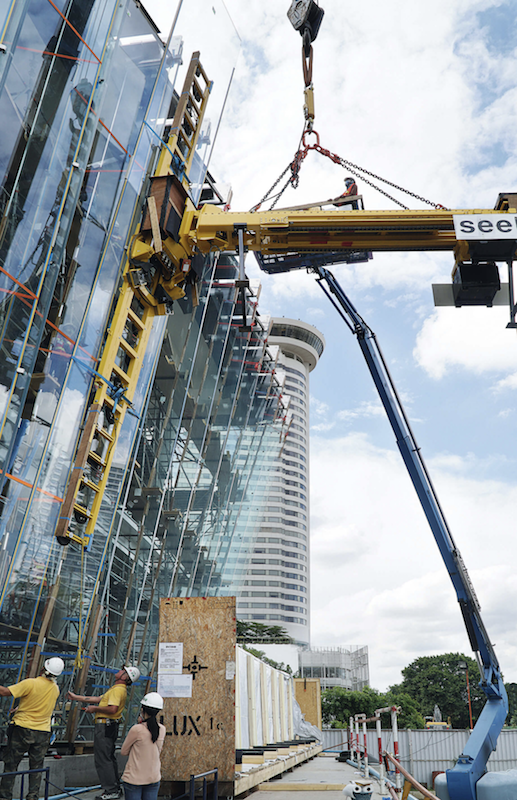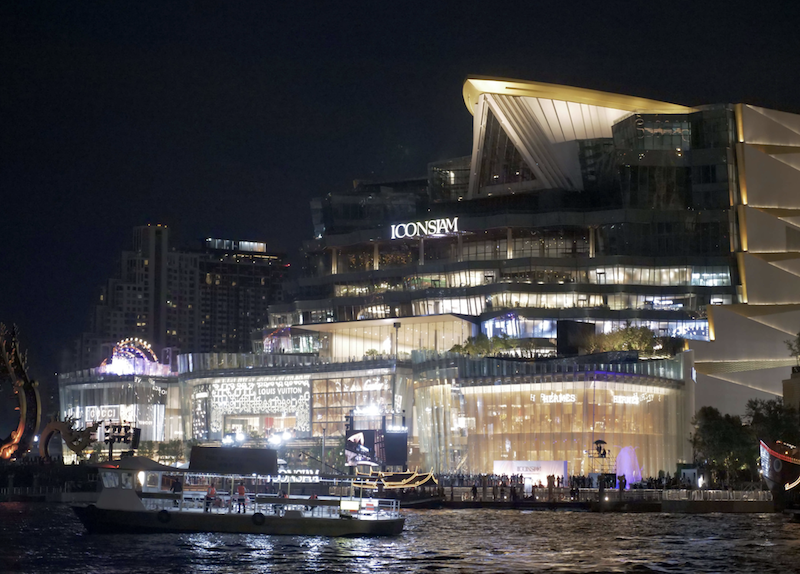When it opened along the Chao Phraya River in Bangkok, Thailand, on Nov. 10, the massive luxury shopping mall Iconsiam—self-identified as “the Icon of Eternal Prosperity”—boasted a number of firsts, including the longest (400-plus meters) water feature in Southeast Asia, and the first project in the country to integrate road, rail, and water transportation. (The complex is 1 kilometer from a station for the BTS Skyway monorail that will be completed next year.)
This 750,000-sm (8.072-million-sf) mixed-use complex, with 525,000 sm of retail space over 10 floors, is connected to Thailand’s first Apple store (and the largest in Asia), and also features a 10,000-sm River Park, a 3,000-seat auditorium, the National Treasure Museum, and two condo towers.
The complex, which cost 54 billion Thai baht to complete (the equivalent of US$1.67 billion, based on today’s currency exchange rate), is being positioned as a regional destination attraction. Its owners—the retail developer Siam Piwat, the conglomerate Charoen Pokphand Group, and MQDC Magnolia Quality Development—reportedly spent at least 1 billion baht promoting its complex’s debut, which included an opening-night performance by Alicia Keys and a red-carpet parade whose celebrities included the actress Naomi Watts.
But Iconsiam is more than just glitz and one-upmanship. From an engineering standpoint, it is distinguished by a pillarless suspended all-glass façade that is among the world’s longest: 300 meters long, up to 24 meters high, and having a surface area of 5,300 sm.
Iconsiam’s designer, Urban Architects, specified a pleated arrangement of glass panes that recalls local values and beliefs tied to the river, including “krathong” (a floating, folded sculpture) and “baisri” (the art of traditional flower arrangement with folded leaves.)

Installation of the glass panel assembly was achieved with a specially manufactured suction unit that allowed crews to position the panes into different angles. Image: Seele
To create this effect, the project’s building team, which included the façade construction specialist Seele, devised a special large-format (up to 25.6 sm for one piece), high-precision glass component weighing up to 3.5 tons per pane.
The façade is comprised of 333 glass panes that are supported by an equal number of 8- and 16-meters-long glass “fins.” The heat-strengthened glass used for the façade, known as TVG, was produced by Sedak. (This process cools the glass at a slower intensity, thereby producing compressive stresses that increase the glass’s strength.)
Seele produced the fins and stainless steel “shoes” for the façade off site at one of its locations in Germany.
The weight of the panes is absorbed at their lower end by transoms. Steel components connected directly to the glass were designed as bolted connections to eliminate losses in accuracy from welding distortion.
To install the façade assembly, Seele specifically developed for this project an apparatus with two suction units with counterweight and three-axial adjustment, which made it possible to lift the glass into its double-inclined position. (The glass fins have a 12-degree angle of inclination from the vertical. The inclination of the façade’s overhang is between 0 and 14 degrees.)
During the installation, custom-wood supports that formed the façade’s contour were used to temporarily stabilize the fins.
Thomas Spitzer, Managing Director of Se-Austria, a company within Seele, said in a prepared statement that the Building Team was able to complete the façade’s construction in under two years because the engineering and production were provided by a single source. “Iconsiam is a unique project for us,” he said.
Related Stories
| Aug 11, 2010
AAMA leads development of BIM standard for fenestration products
The American Architectural Manufacturers Association’s newly formed BIM Task Group met during the AAMA National Fall Conference to discuss the need for an BIM standard for nonresidential fenestration products.
| Aug 11, 2010
Embassy's dual façades add security and beauty
The British government's new 46,285-sf embassy building in Warsaw, Poland's diplomatic quarter houses the ambassador's offices, the consulate, and visa services on three floors. The $20 million Modernist design by London-based Tony Fretton Architects features a double façade—an inner concrete super structure and an outer curtain wall.
| Aug 11, 2010
Precast All the Way
For years, precast concrete has been viewed as a mass-produced product with no personality or visual appeal—the vanilla of building materials. Thanks to recent technological innovations in precast molds and thin veneers, however, that image is changing. As precast—concrete building components that are poured and molded offsite—continues to develop a vibrant personality all it...
| Aug 11, 2010
Seven tips for specifying and designing with insulated metal wall panels
Insulated metal panels, or IMPs, have been a popular exterior wall cladding choice for more than 30 years. These sandwich panels are composed of liquid insulating foam, such as polyurethane, injected between two aluminum or steel metal face panels to form a solid, monolithic unit. The result is a lightweight, highly insulated (R-14 to R-30, depending on the thickness of the panel) exterior clad...
| Aug 11, 2010
Nurturing the Community
The best seat in the house at the new Seahawks Stadium in Seattle isn't on the 50-yard line. It's in the southeast corner, at the very top of the upper bowl. "From there you have a corner-to-corner view of the field and an inspiring grasp of the surrounding city," says Kelly Kerns, project leader with architect/engineer Ellerbe Becket, Kansas City, Mo.
| Aug 11, 2010
AIA Course: Enclosure strategies for better buildings
Sustainability and energy efficiency depend not only on the overall design but also on the building's enclosure system. Whether it's via better air-infiltration control, thermal insulation, and moisture control, or more advanced strategies such as active façades with automated shading and venting or novel enclosure types such as double walls, Building Teams are delivering more efficient, better performing, and healthier building enclosures.
| Aug 11, 2010
Glass Wall Systems Open Up Closed Spaces
Sectioning off large open spaces without making everything feel closed off was the challenge faced by two very different projects—one an upscale food market in Napa Valley, the other a corporate office in Southern California. Movable glass wall systems proved to be the solution in both projects.







